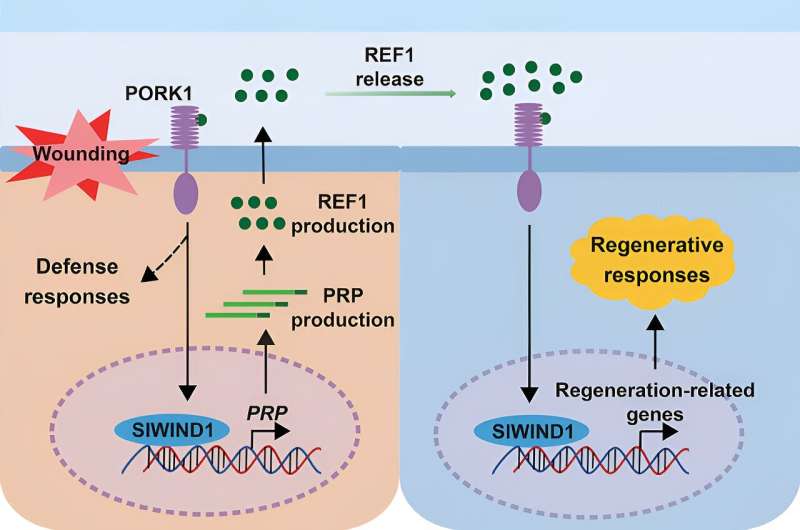This article has been reviewed according to Science X's editorial process and policies. Editors have highlighted the following attributes while ensuring the content's credibility:
fact-checked
peer-reviewed publication
trusted source
proofread
Scientists discover primary wound signal that promotes plant regeneration

In a study published in Cell on May 22, researchers led by Prof. Li Chuanyou from the Institute of Genetics and Developmental Biology (IGDB) of the Chinese Academy of Sciences report their discovery that REGENERATION FACTOR1 (REF1) is the primary local wound signal that instigates plant regenerative responses. This discovery suggests a convenient method for improving the transformation efficiency of difficult-to-transform crops by boosting their regeneration capacity.
Compared to their animal counterparts, plants experience injuries more frequently and have evolved an extraordinary capacity to cope with them. Upon injury, plants immediately activate defense responses to prevent pathogen infection and/or insect attack. In parallel, plants activate cellular reprogramming to repair damaged tissues and regenerate lost body parts.
While the wound signals and signaling cascades used by plants to activate wound-induced defense responses are well understood, the molecular mechanisms underlying wound-induced regenerative responses remain obscure.
Although wounding is essential for initiating various types of organ regeneration, the biochemical nature of the putative local wound signals governing this process has remained a mystery for centuries.
Furthermore, the regenerative capacity of plants in nature varies widely among species and genotypes, which is one of the major hurdles to fully realizing the potential of genetic transformation and genome editing technologies for crop breeding. Therefore, among 125 important unanswered questions listed by the journal Science, "What controls organ regeneration?" was selected as one of the top 25 questions.
Considering that regeneration and defense are interconnected facets of plant wound responses, it is reasonable to speculate that tomato mutants defective in the putative regeneration signal would show both compromised regeneration capacity and impaired defense responses.
Based on this principle, the researchers identified a spr9 mutant that is defective in both wound-induced defense responses and regenerative responses. spr9 primarily affects local defense responses and abolishes the capacity of wound-induced callus formation and shoot regeneration, suggesting that the SPR9 gene plays a dual role in regulating wound-induced local defense and organ regeneration.
Gene cloning studies revealed that the SPR9 gene encodes a precursor of a peptide. Depletion of SPR9 abolished the regenerative capacity of tomatoes, and overexpression of SPR9 resulted in enhanced regenerative capacity.
Moreover, application of its peptide product dramatically increased regeneration capacity. Therefore, this peptide was designated as REGENERATION FACTOR1, or REF1.
Further studies showed that REF1 is perceived by the receptor PORK1. When plant cells are injured, REF1 binds its receptor PORK1 to activate WIND1, a master regulator of wound-induced cellular reprogramming, thereby initiating regenerative responses.
Meanwhile, activated WIND1 binds the promoter of the REF1 precursor gene to activate its expression, thereby amplifying REF1 signaling for tissue repair and organ regeneration. Thus, REF1 acts as a phytocytokine to orchestrate wound-induced organ regeneration.
Since REF1 and its receptor are highly conserved in both dicot and monocot plants, REF1-induced enhancement of regeneration capacity is a widespread mechanism. Application of REF1 has dramatically improved transformation efficiency in several difficult-to-transform crops, including soybeans, wheat, and maize.
The discovery of REF1 not only answers the long-standing question of how plants initiate organ regeneration, but also provides a convenient and universal method of boosting the transformation efficiency of crops in a species- and/or genotype-independent manner.
More information: Wentao Yang et al, Peptide REF1 is a local wound signal promoting plant regeneration, Cell (2024). DOI: 10.1016/j.cell.2024.04.040
Provided by Chinese Academy of Sciences


















